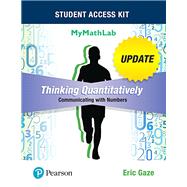For courses in quantitative reasoning, quantitative literacy, numeracy, or liberal arts mathematics for non-STEM students.
Empowerment through Numbers
Thinking Quantitatively: Communicating with Numbers, by Eric Gaze, is more than a simple math course; it develops well-rounded students who can think critically, while showcasing how we use numbers to communicate in everyday life. Today’s students need to be numerically literate to thrive in our increasingly data-driven society, and this program teaches students the math needed to develop the critical thinking skills required to make good decisions and become informed citizens. Thinking Quantitatively is intended for use in a credit-bearing quantitative reasoning or liberal arts math course for non-STEM students. The Update includes new coverage of Probability topics, Excel tutorials created by the author, and increased Excel homework available to be assigned.
Built in MyMathLab, this program offers an interactive eText, videos, just-in-time tutorials, assessment, and Guided Worksheets. The Guided Worksheets are a printed resource students will use for note-taking and working out problems, and can be used as an in-class resource or to facilitate learning at home in tandem with their MyMathLab course. Authentic, real-world problem-solving using spreadsheet software gives students the opportunity to develop sophisticated reasoning about everyday topics. Thinking Quantitatively enriches the learning experience by providing students with the tools to process the quantitative data that is pervasive in their everyday lives.
Personalize learning with MyMathLab
MyMathLab is an online homework, tutorial, and assessment program designed to work with this text to engage students and improve results. Within its structured environment, students practice what they learn, test their understanding, and engage with media resources to help them absorb course material and understand difficult concepts. NEW! The Update MyMathLab course provides additional resources, including author-crafted videos and exercises, and expanded Excel Homework to build problem-solving and reasoning skills while working through the math.
Note: You are purchasing a standalone product; MyLab™ & Mastering™ does not come packaged with this content. Students, if interested in purchasing this title with MyLab & Mastering, ask your instructor for the correct package ISBN and Course ID. Instructors, contact your Pearson representative for more information.
If you would like to purchase both the physical text and MyLab & Mastering, search for:
This package contains the MyMathLab access kit plus the Guided Worksheets.
0134539532 / 9780134539539 Thinking Quantitatively: Communicating with Numbers Update MyMathLab Access Card with Guided Worksheets -- Access Card Package
Package consists of:
- 0134540441 / 9780134540443 Guided Worksheets for Thinking Quantitatively: Communicating with Numbers Update
- 0134542703 / 9780134542706 Thinking Quantitatively: Communicating with Numbers Update with MML Access Card












